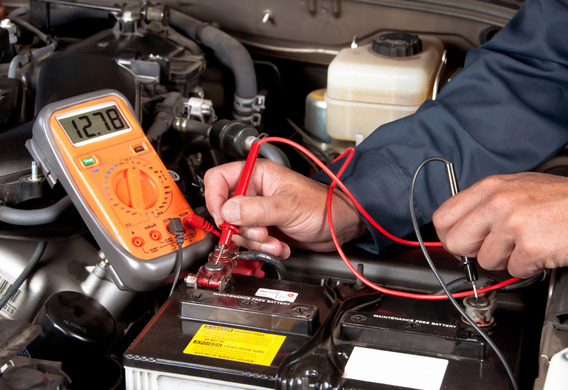
Sometimes, after a long car park, you can only hear the relays or the starter is activated, but it is not cool. All these symptoms show that the battery is fully or partially discharged during parking.
Unmounted headlamps or position lamps are often the cause
It is not possible to explain this-the serviceable battery is discharged for a long time, a few months-a leak has occurred, or there is a malfunction in the battery charging system, and the driver, putting the car in the parking lot, did not know that the battery was not sufficiently charged.
Common causes of current leakage
Diagnosing the cause of the premature detente, it is necessary (and this is the general rule for diagnosing any failure in the car) to weed out the causes that do not indicate a malfunction. Or rather, the inconsideration of the car. For example, the battery can be old and exhaust, the terminals are covered with ocaline, or the wires may be in a bad condition, etc., often the reason for the discharge is the unconnected headlamps or the position lamps. If you think that one of the above or similar factors is the cause of the discharge, you can see that the transaction has failed and that the location of the leak is to start.
Battery current consumption limits
The car has a number of "authorized" permanent consumers of electricity. It can be hours, memory of an electronic engine control unit, an alarm, and so on. All of them are permanently locked because the memory of the ECU, for example, is not recommended, otherwise the block will be moved to learn the current settings again, and the alarm at all works just in the moments when the engine is turned off and the car is standing on the spot.
It follows that the current consumption of the current is normal and must have a constant value, which can be calculated by adding the consumption of all consumers. For example, the alarm can consume about 20 mA, memory of hours-1 mA, magneto-3 mA, and so on. Total consumption must fluctuate between 50 and 80 mA. This is a small consumption (for example, even one lit lamp is consuming 500 mA), and it is not even possible to reduce the current battery with such leaks in the winter.
If, however, the results of measurements indicate that the average constant consumption is significantly exceeded, there is a leak in the onboard network and should be corrected.
How to determine if current leak is present
The main reasons for the intensive discharge are two-presence of an "unauthorised" consumer, or short circuit in the side circuit. The leakage of the current absorbed by the consumer can be detected by a household appliance named "multimeter".

To find a malfunction, the multimeter is required to be placed in ampere mode, without forgetting that the current in the onboard network is constant, and to put the measurement range up to 10 Amps.
Before the beginning of the measurements, the ampermeter must be properly connected to the onboard network and the consumers of the current must be switched off, if possible.
Unauthorized current consumption is often caused by some additional equipment
The ampermeter is most commonly connected to a break in the chain. In order to create a gap, it is necessary to remove the battery from the top of the battery, and then close the circuit by connecting one wire of the ampermeter to the terminal itself and the other to the removed wire. In no case may a multimeter be connected to an ampermeter, a plus or minus cell battery, as this action will result in a short circuit and the fuse will burn.
If you have done everything correctly, the display of the multimeter will illuminates a number corresponding to the power of the current consumed by permanently connected electrical appliances. If the power is higher than normal, then there's a leak.
Search for current leakage
The reason for the unauthorized consumption of current is often any device from the number of additional equipment (state or non-staff), which is becoming more and more in modern cars every year.
Starting to look for the leak, first of all, attention should be paid to the devices installed in the cars, for example, on an alarm or an additional cooling fan. The vehicle transaction is well protected and a short circuit is possible only after significant metal damage (the destruction of a protective cover caused by an accident, for example). On the other, it is necessary to put in the first place an untenable device, which appears to be suitable for a superficial inspection, in fact it is not. This is the most frequent occurrence of this wiring-the most common cause of leakage current.
For example, the wiring may be too close to the engine block and start to melt under the influence of heat from the engine or just rub the edge of the metal arm. Both leads to isolation and short circuit.
So, the algorithm for finding the leak, on the advice of the electrically-masters, should be that way. By measuring the power of the ampermeter and verifying that there is a leak, it is necessary to switch to visual inspection, starting with the untaustly installed devices and their parts exposed to mechanical effects. For example, in the case of an alarm this can be "trailers"-special long buttons, breaking and closing chain when opening and closing doors.
Once you are satisfied that there are no visible signs of deformation, burnout and corrosion on the wires, it is worthwhile to use more sophisticated diagnostic techniques to narrow down the search. For example, electricists often pull the fuses out of each circuit in turn, carefully watching the contact with blurring contacts or not. If there is a spark, and there is no voltage in the circuit (the instruments that it nourish, shall be switched off at this moment), it is possible that the leakage of the current is there.
After identifying the suspect part of the transaction, it is necessary to search the wiring, "to call" the wire, one by one for the other. This is done by the same multimeter, but in the mode of an omm, as in this case it is necessary to observe the resistance of the line of interest. The resistance, as well as the current of the normal discharge of the battery, shall be greater than zero, and the specific value depends on the section of the measured wire.
So, finding the leak is quite feasible if you learn how to use a multimeter and master the method of exception, paying attention to the various weirdness of the wires, the trace of rust near the wiring, and so on.







